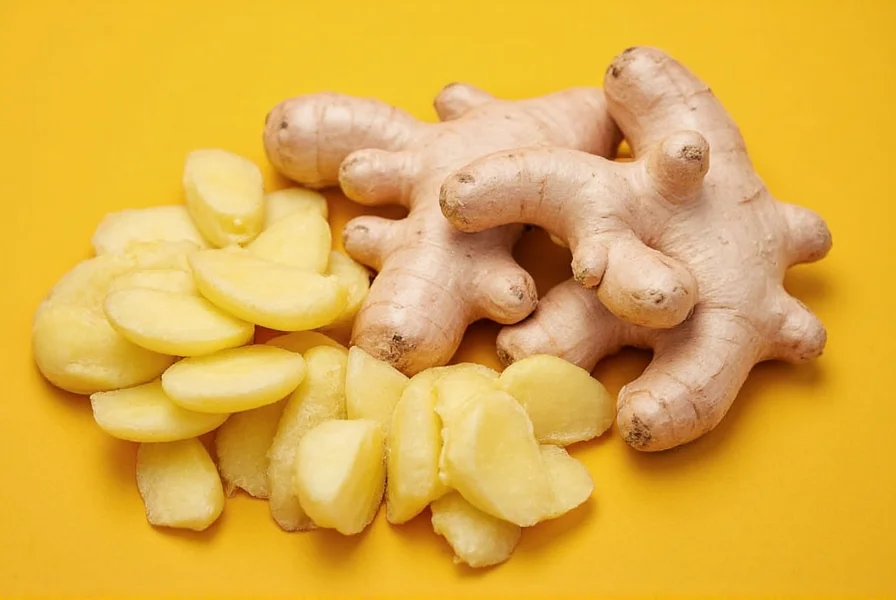Understanding the unique properties of new ginger can transform your cooking experience and maximize the health benefits this versatile root offers. Harvested before it fully matures, new ginger maintains a distinctive pinkish hue at the growing tips and features a pale yellow interior with exceptional juiciness. This early harvest stage creates a culinary ingredient that works beautifully in both raw and cooked applications without overwhelming other flavors.
What Makes New Ginger Special
New ginger (Zingiber officinale) represents the youthful stage of the ginger plant, typically harvested between 140-180 days after planting. During this early growth phase, the rhizomes haven't developed the tough fibers and intense heat characteristic of mature ginger. The cellular structure remains more tender, with higher water content (approximately 80% compared to 65% in mature ginger), creating a product that's exceptionally versatile in the kitchen.
Professional chefs particularly value new ginger for delicate preparations where the sharp bite of mature ginger would dominate. This younger variety works beautifully in raw applications like salads, ceviche, and fresh juices where its subtle citrus notes can shine through. The natural sugars haven't fully converted to gingerols (the compounds responsible for ginger's heat), resulting in a flavor profile that's more floral and slightly sweet.
| Characteristic | New Ginger (Young Ginger) | Mature Ginger |
|---|---|---|
| Harvest Time | 5-6 months after planting | 8-10 months after planting |
| Texture | Tender, juicy, almost succulent | Firmer, fibrous, woody |
| Skin Thickness | Very thin, often doesn't need peeling | Thick, requires peeling |
| Flavor Profile | Milder, less pungent, slightly sweet | Stronger, spicier, more intense |
| Best Culinary Uses | Raw applications, salads, delicate dishes | Cooking, baking, strong-flavored dishes |
| Storage Life | 2-3 weeks refrigerated | Several weeks refrigerated |
Selecting Quality New Ginger
When shopping for fresh ginger, knowing how to select the best new ginger makes all the difference in your culinary results. Look for roots that feel heavy for their size with smooth, taut skin that shows no wrinkles or soft spots. The best new ginger displays a pale yellow or slightly pinkish hue at the growing tips, indicating its youthful stage. Avoid any roots with visible mold, dark spots, or a dried-out appearance.
Seasonality matters when seeking the freshest new ginger. In most markets, the peak season for young ginger runs from spring through early summer, though availability varies by region. Asian grocery stores often carry new ginger year-round due to staggered harvesting practices in ginger-producing countries. When properly selected, quality new ginger should feel firm but yield slightly when gently pressed, indicating optimal moisture content.

Proper Storage Techniques for Maximum Freshness
Preserving the delicate qualities of new ginger requires specific storage approaches different from mature ginger. The high moisture content that makes young ginger so desirable also makes it more perishable. For short-term storage (up to 3 weeks), wrap the ginger in a paper towel to absorb excess moisture, then place it in an airtight container in the refrigerator's vegetable drawer.
For longer preservation while maintaining texture, consider storing new ginger in a jar of dry sherry or mirin in the refrigerator. This traditional Asian method not only extends shelf life to 1-2 months but also subtly enhances the flavor. Freezing represents another excellent option—simply peel the ginger (if desired), cut into usable pieces, and store in freezer bags. Frozen new ginger grates beautifully without thawing, making it perfect for immediate use in recipes.
Culinary Applications of Fresh Ginger
The versatility of new ginger in cooking stems from its delicate flavor profile that complements rather than dominates. In Japanese cuisine, it appears as shin shoga in dishes like sunomono (vinegared salads) where its tender texture shines. Thai chefs use young ginger in certain curry pastes and fresh salads where mature ginger would be too harsh.
When preparing new ginger for cooking, remember that peeling is often unnecessary thanks to its thin skin. A quick scrub with a vegetable brush usually suffices. For raw applications like garnishes or in sushi, slice the ginger paper-thin using a mandoline for the most delicate presentation. In baking, new ginger works beautifully in cakes and cookies where its subtle flavor won't overpower other ingredients.
Health Benefits of Fresh Ginger Root
While all ginger varieties offer health benefits, new ginger provides unique advantages due to its different chemical composition. The lower concentration of gingerols makes it gentler on sensitive stomachs while still delivering digestive benefits. Research published in the Journal of Agricultural and Food Chemistry indicates that young ginger contains higher levels of certain antioxidants compared to mature ginger.
The anti-inflammatory properties of fresh ginger make it valuable for managing muscle soreness and joint pain. A 2020 study in the Journal of Pain Research found that regular consumption of ginger (in any form) significantly reduced muscle pain after exercise. For nausea relief, particularly morning sickness during pregnancy, new ginger's milder flavor often proves more palatable while remaining equally effective.
Practical Tips for Using New Ginger
Maximize your new ginger experience with these professional kitchen tips. When grating fresh ginger, freeze the root for 15 minutes first—this firms up the texture and makes grating easier while minimizing fiber release. For beverages, slice new ginger thinly and bruise the slices with the back of your knife to release maximum flavor without bitterness.
When substituting new ginger for mature ginger in recipes, use about 25% more by volume to achieve similar flavor intensity. Conversely, when replacing mature ginger with new ginger, reduce the amount slightly to prevent overwhelming other flavors. Remember that cooking time affects ginger's flavor profile—add new ginger later in the cooking process to preserve its delicate characteristics.
Frequently Asked Questions
What is the difference between new ginger and mature ginger?
New ginger (harvested at 5-6 months) has thinner skin, higher moisture content, and a milder, slightly sweet flavor compared to mature ginger (harvested at 8-10 months). Young ginger is more tender and often doesn't require peeling, while mature ginger develops stronger heat and fibrous texture. The cellular structure of new ginger makes it ideal for raw applications where mature ginger would be too pungent.
How can I tell if ginger is fresh and high quality?
Fresh new ginger should feel heavy for its size with smooth, taut skin showing no wrinkles or soft spots. Look for pale yellow or slightly pinkish growing tips, which indicate youthfulness. The root should yield slightly when gently pressed but remain firm. Avoid ginger with visible mold, dark spots, or a dried-out appearance. When broken, quality new ginger should release a clean, citrusy aroma without mustiness.
Does new ginger need to be peeled before use?
Generally, new ginger doesn't require peeling due to its thin, tender skin. A thorough scrub with a vegetable brush usually suffices for most culinary applications. The skin contains valuable nutrients and flavor compounds, so keeping it intact maximizes both nutritional value and taste. Only peel new ginger if the skin appears damaged or if you're using it in applications where texture is critical, such as paper-thin slices for sushi garnishes.
What are the best ways to store fresh ginger to keep it from spoiling?
For optimal freshness, wrap new ginger in a paper towel to absorb excess moisture, then place it in an airtight container in the refrigerator's vegetable drawer. This method preserves quality for 2-3 weeks. Alternatively, store it submerged in dry sherry or mirin in the refrigerator for up to 2 months. Freezing works exceptionally well—peel if desired, cut into pieces, and store in freezer bags. Frozen ginger grates beautifully without thawing and maintains quality for 6 months.
Can I substitute new ginger for mature ginger in recipes?
Yes, but with adjustments. When substituting new ginger for mature ginger, use about 25% more by volume to achieve similar flavor intensity. Conversely, when replacing mature ginger with new ginger, reduce the amount slightly to prevent overwhelming other flavors. Remember that new ginger's delicate compounds break down faster with heat, so add it later in the cooking process to preserve its unique characteristics. For raw applications, new ginger often provides superior results without modification.











 浙公网安备
33010002000092号
浙公网安备
33010002000092号 浙B2-20120091-4
浙B2-20120091-4